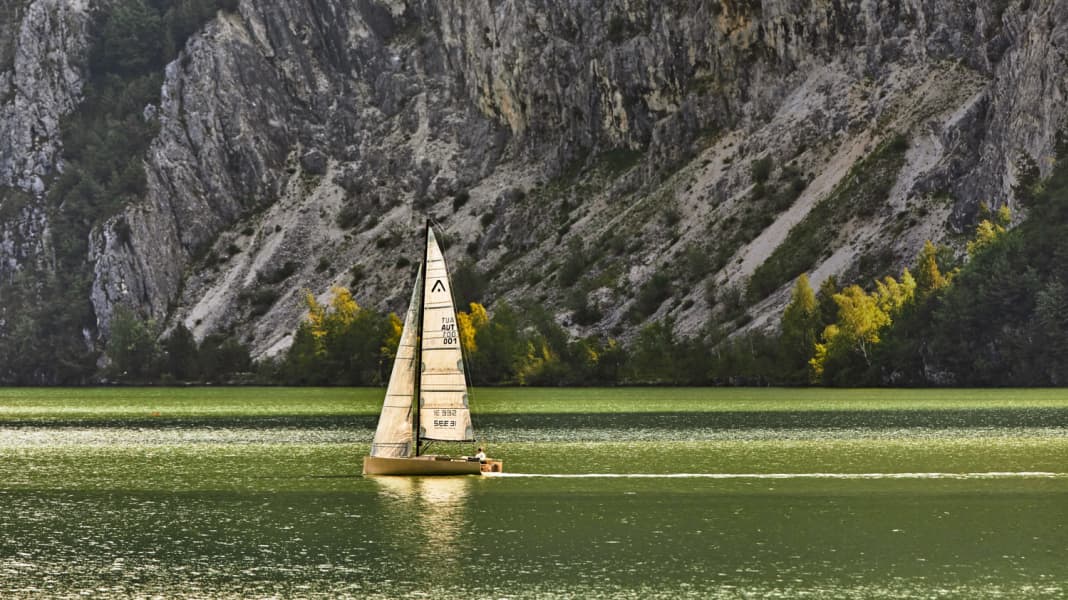
Alpine lakes in this article:
Framed by steep cliffs, the water glistens in the morning light. Hardly a breath of wind blows, as if everything stands still, including time. The water shimmers in spherical shades of green and turquoise. It is so crystal clear that every stone is visible on the nearby bottom. You are almost reminded of a summery fjord in Norway. But this is Austria, this is Lake Traunsee - actually known for big regattas, wild races. At this moment, however, it is calm, almost epic. Clouds and mountain peaks are reflected in it. The panoramic view of the 1,691 metre high Traunstein massif is almost reverent, the backdrop is so imposing, so intense.
Adrenalin-fuelled kiters and surfers come from the beach. Their equipment tucked casually under their arms, they stroll to the camper buses in the car park. They have taken advantage of the strong southerly breeze that blows at night and into the early hours of the morning. It's called the upper wind here. But that's all over now. It has blown itself out. Now come the hours for the connoisseurs. This change of pace is typical of many lakes in the Alps and Alpine foothills. We show you some of the diversity of these dream areas.
The most beautiful alpine lakes for sailing:
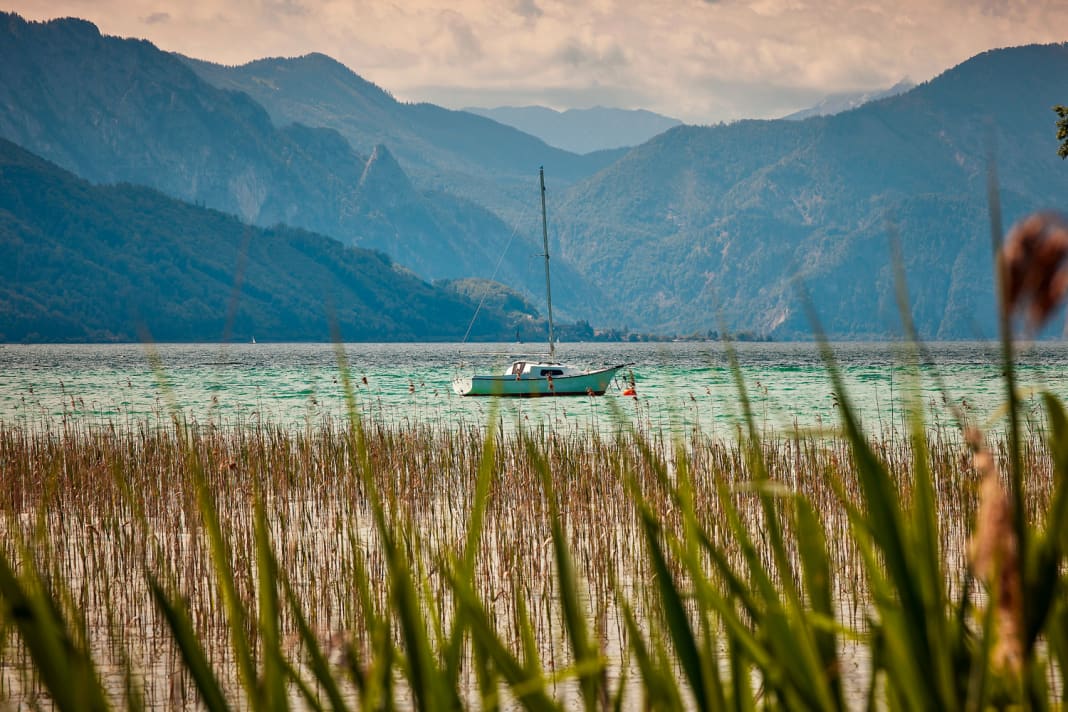





The cradle of water sports
The Alpine lakes are not just local recreation areas and postcard motifs. Due to their thermal characteristics, frequently shifting winds and sometimes extreme weather conditions, they require a sensitive hand on the tiller and sheet. This makes them the perfect course for a professional career on the water. The Austrian Hubert Raudaschl is the personification of this. He took part in ten Olympic Games and won numerous world championship titles in dinghy classes during his active career. Ernesto Bertarelli from Lake Geneva has also been sailing since his earliest childhood and continues to enjoy success on international regatta courses to this day. His biggest coup: in 2003 and 2007, he brought the America's Cup from the Hauraki Gulf in New Zealand to the Swiss mountains.
The mountain lakes are certainly not suitable for eating up miles, especially as distances within are measured in kilometres anyway. Even the largest areas are too limited. At some point there is a rock, a pebble beach or a reed-lined promenade. However, it is precisely the natural boundaries of gneiss and granite that provide a fascinating variety in the comparatively small areas of the Alpine lakes - and for alternative leisure activities. A calm day can be used for a hike in the mountains or a cycle tour around the lake. If the wind is a little too strong for sailing, some people switch to surfing or kiteboarding. And not to give the wrong impression: Long distances are of course also possible. Almost every inland lake has its own long course, which regularly brings together impressive starting fields - always larger than on the North Sea or Baltic Sea.
Yes, the wind is sometimes a bit of a problem at the Alpine lakes. But thermals almost always form at midday when the pressure is high. Sometimes you can even set your watch to it.
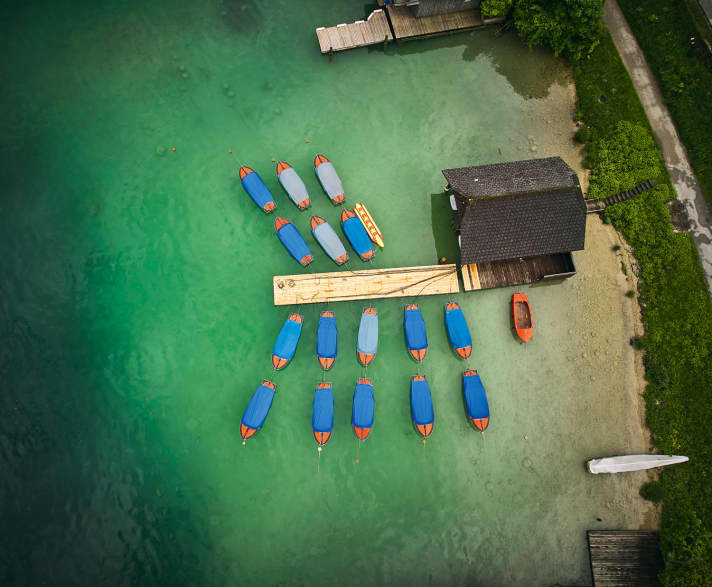
The most beautiful sailing areas in the Alps
Attersee (Austria): Rosenwind area
With around 50 kilometres of shoreline, it is one of the largest Alpine lakes in Sisi Land. And one of the most beautiful anyway. In summer, the water of Lake Attersee is a delightful Caribbean turquoise colour. On good days, the rose wind blows from the north, fuelled by the warming of the mountains to the south. Salzburg is only an hour's drive away. Nevertheless, it never gets too busy. The Union-Yacht-Club Attersee (UYCAS), one of the oldest sailing clubs in Austria, is based here.
Lake Constance (Germany): Three countries, one sea
Strictly speaking, the frequently used synonym "Swabian Sea" is quite a misnomer. In fact, Lake Constance also borders Bavaria and Baden nationally and Austria (at least a little) and Switzerland internationally. Opinions differ as to whether it can be described as a sea because of its size. With more than 270 kilometres of shoreline (28 in Austria and 72 in Switzerland), it is undoubtedly one of the largest inland lakes in Europe. And when the wind blows, it can inspire respect with waves up to 3.50 metres high. Its status is so special that it requires its own licence to sail, the Lake Constance skipper's licence; for holidaymakers with other licences, there is a kind of "small" guest licence. Various charter companies mostly offer small cruisers, less often yachts. Despite larger cities such as Constance and Lindau and despite the influx from the Stuttgart and Munich metropolitan areas, the area has retained a charming doll's house atmosphere here and there, such as in the picture on the Wasserburg peninsula
Lake Geneva (Switzerland): Between wine and stone
Capricious weather is nothing unusual on the large Alpine lakes. However, what brewed up over Lake Geneva in June 2019 during the Bol d'or Mirabaud, the largest inland regatta in the world with over 500 yachts, actually fits the description of the Roaring Forties better than the Swiss Riviera, as the glamorous palm-lined northern shore from Lausanne to Montreux is known: Gusts of up to 60 knots swept across the lake; hail, rain and spray hit crews and yachts hard. The sky was practically falling on the participants' heads. Yet the 580 square kilometre lake, which is shared by the Swiss and French, has mostly lovely sides. To the north-east lie the terraced vineyards of Lavaux, Switzerland's largest wine-growing region and a UNESCO World Heritage Site. To the south, beyond the sailing masts and city backdrop, towers Mont Blanc at over 4,800 metres above sea level. An area between the sky and fresh water, fed by the still glacier-fresh young Rhone, which flows into the Mediterranean some 800 kilometres beyond Geneva. Marvellous!
Lake Starnberg (Germany): Munich's bathtub
The legacy of the Isar-Loisach glacier, which bequeathed Lake Starnberg to the Bavarians, is much smaller, although no less beautiful. Just 25 kilometres from Munich, thousands of city dwellers plunge into the cool water, especially on hot midsummer days. The nickname "Munich's bathtub" is no coincidence. Anyone who has made it from the street canyons to the lakeshore, or even better: out onto the lake, can experience a breathtaking Alpine panorama. "Especially when the foehn is blowing, the view stretches far into the mountains. Then you get the feeling that the Zugspitze rises up just behind Seeshaupt," says Felix Kempf. He has been in contact with the clear water since he was a small child. As often as his job allows, the 52-year-old rows out to the buoy and gets his classic 5 metre racing yacht ready to sail. The 1945 gem forms a worthy backdrop to the magnificent Alpine panorama. The classic yacht scene is also well represented here, as it is everywhere on the mountain lakes. Monetary donations from wealthy owners and the craftsmanship of local boat builders often work wonders.
"The fantastic location of the lake below the Alpine chain is undoubtedly a visual highlight, but sometimes also causes rapidly changing weather conditions. On most days, the wind comes from the northern quadrant. However, when it turns to the south-west, it can become violent, with gusts up to hurricane force and thunderstorms. Then it's better to get off the water quickly, because running off endlessly like at sea is not an option here. So you have to be vigilant" (Felix Kempf, Lake Starnberg)
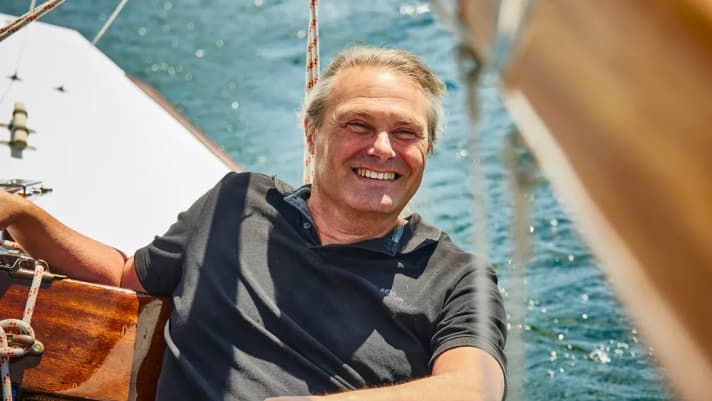
Lake Traunsee (Austria): Fjord of the Prealps
The lake is still. Nothing is happening. Do you go straight back to bed on a morning like this? Or do you put on your hiking boots to explore the mountains, as Manfred Curry once recommended? The Bavarian sailing legend, also known for the clamp named after him, the tinkerer, suggested as early as 1936 that regatta sailors should first get an overview of the topographical conditions in foreign waters. Franz Lackerbauer, the Traunsee whisperer, doesn't need to do this: "It'll be fine with the wind, just sit tight for a while. Then it'll blow," he says. You can rely on that, "most of the time...". Franz should know. He won three world championship titles in the Shark 24 as foresailor, is co-founder of the Ebensee sailing club and is now its president. The lake is his home, his knowledge of local wind systems his capital for successful races. When he talks, there is a sparkle in his eyes. Every Alpine lake district has its own "wind machine", and here's how it works on Lake Traunsee in good weather: At night, the south wind blows until around 9 a.m. the following day, then there is a three-hour lull, and from midday the north wind kicks in: the phenomenon of the upper and lower wind.
"The special thing about Lake Traunsee is that it offers everything - from the gentle hills at the northern end to the fjord-like, rugged part in the south with mountains over 1,500 metres high. The very difficult wind conditions, which can best be compared with those on Lake Garda, present a challenge. Thermals provide the best breeze during the day, especially in the bay of Ebensee in fair weather. It is no coincidence that this is a hotspot for the growing kite and wingfoil community. The lake is also a regular venue for world and European championships in various boat classes." (Franz Lackerbauer, Traunsee)

Lake Como (Italy): Lanes
A lake like an upside-down "Y", that's how Lago di Como appears from a bird's eye view. It is one of the most beautiful bodies of water on the southern side of the Alps, which is partly due to its Mediterranean flair. Palm trees thrive on its shores, old alleyways and fantastic restaurants make après-sail a pleasure, as here in Varenna, where the sun shines through the historic archway just before it sets. Bellissimo!
Lake Garda (Italy): Guaranteed wind
The "wind machine" on Lake Garda in northern Italy is also precisely programmed: around midday, the Ora brings a constant breeze from the south, which develops due to the rising heat in the mountain valleys to the north. Even if things change from time to time - due to cloud cover or a disruptive gradient wind, for example - Lake Garda is ideal for fast sailing thanks to its constant conditions and temperate climate. Clubs from all over Europe also take advantage of the exceptional climate; training camps are organised from as early as April - from junior opti sailors to star boat professionals, many prepare for the season here. Pleasure sailors will find calmer air in the centre and south. Lago di Garda is characterised by its magnificent landscape with high peaks, steep rocky slopes in the west, small bathing bays and cold, clear water. To the east of the lake are the wine-growing areas of Bardolino, Soave and Valpolicella.
Chiemsee (Bavaria): Idyll in white and blue
Even cruising sailors sometimes learn the skills for the really big voyage on the inland lakes. Bobby Schenk, for example, benefited from the lessons on Lake Chiemsee: "We've had weather here that even challenges circumnavigators," recalls the retired district judge. "During a Föhn storm in summer, it swept over our anchorage and an entire regatta field out of the blue in a matter of minutes. Within a minute, the white sails on the horizon had disappeared because the more than 60 dinghies had all capsized." The rustic lake with its two islands can also be quite tame, a truly Bavarian idyll on the edge of the Alps. Schenk loves to experience the romance of sailing in Rotter Bucht: "Just like in the South Seas - only without the palm trees! And the noise from the nearby A8 motorway can be interpreted as the sound of waves."
There are days under a blazing sun when the only way to cool off is to jump into the water while the yacht bobs in the doldrums. So what could Bobby Schenk learn here for his adventures? "You can experience everything from a leaden calm to a crashing storm in one season - a good taster for sailing around the world! The lake on which we had to practise mooring manoeuvres at the jetty in April in snow flurries was a tough but good teacher for me."
"Lake Chiemsee has surrounded me every day since I was born! I live and work on Fraueninsel and can see the water, mountains, meadows and forest through the open shipyard gate and experience the sometimes moody weather. The biggest challenge is not necessarily a meteorological one, but the increasing flow of tourists. For me, this usually means slaloming around the SUPs, rowing boats and sailing boats - from those that are actually far too small to those that are really too big. And yet the lake remains my beloved home, whether it's calm or stormy, sunny or foggy, hot or freezing cold." (Peter Heistracher, Chiemsee)
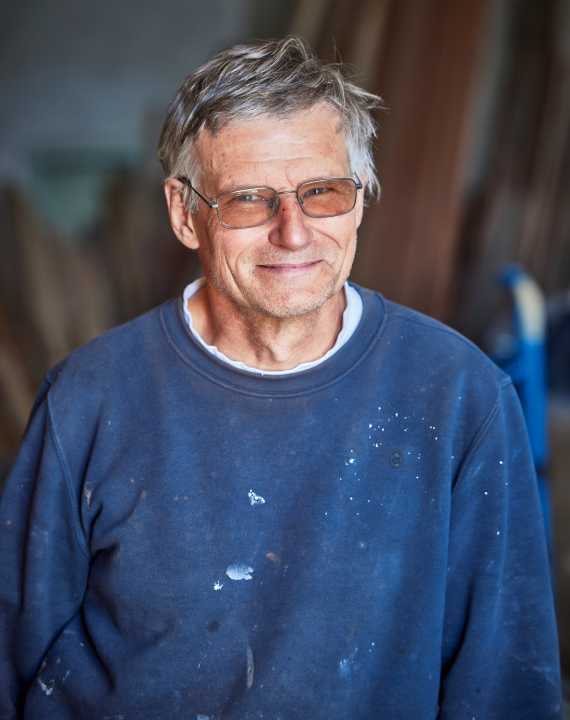
Lake Thun (Switzerland): Fast water
If you think of postcard clichés when you think of the small fjord that formed during the last ice age, you're not entirely wrong. The small, deep Lake Thun is certainly beautiful, but not quiet. This is because there is a very active regatta scene here, including match racing and the Melges class. Lake Geneva and Lake Zurich may be larger and more established. In terms of commitment, however, the people of Thun are in no way inferior to their compatriots. The Interlaken region in the Bernese Oberland also has a lot to offer for an active holiday: Hiking, biking, kayaking, surfing.

